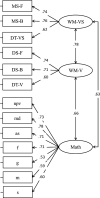Working memory predictors of mathematics across the middle primary school years
- PMID: 31999851
- PMCID: PMC7496726
- DOI: 10.1111/bjep.12339
Working memory predictors of mathematics across the middle primary school years
Abstract
Background: Work surrounding the relationship between visuospatial working memory (WM) and mathematics performance is gaining significant traction as a result of a focus on improving academic attainment.
Aims: This study examined the relative contributions of verbal and visuospatial simple and complex WM measures to mathematics in primary school children aged 6-10 years.
Sample: A sample of 111 children in years 2-5 were assessed (Mage = 100.06 months, SD = 14.47).
Method: Children were tested individually on all memory measures, followed by a separate mathematics testing session as a class group in the same assessment wave.
Results and conclusions: Results revealed an age-dependent relationship, with a move towards visuospatial influence in older children. Further analyses demonstrated that backward word span and backward matrices contributed unique portions of variance of mathematics, regardless of the regression model specified. We discuss possible explanations for our preliminary findings in relation to the existing literature alongside their implications for educators and further research.
Keywords: children; mathematics; verbal; visuospatial.
© 2020 The Authors. British Journal of Educational Psychology published by John Wiley & Sons Ltd on behalf of British Psychological Society.
Conflict of interest statement
All authors declare no conflict of interest.
Figures






Similar articles
-
Working memory predictors of written mathematics in 7- to 8-year-old children.Q J Exp Psychol (Hove). 2020 Feb;73(2):239-248. doi: 10.1177/1747021819871243. Epub 2019 Sep 5. Q J Exp Psychol (Hove). 2020. PMID: 31390931
-
Verbal and visual-spatial working memory and mathematical ability in different domains throughout primary school.Mem Cognit. 2015 Apr;43(3):367-78. doi: 10.3758/s13421-014-0480-4. Mem Cognit. 2015. PMID: 25377509 Free PMC article.
-
The underlying structure of visuospatial working memory in children with mathematical learning disability.Br J Dev Psychol. 2018 Jun;36(2):220-235. doi: 10.1111/bjdp.12202. Epub 2017 Aug 18. Br J Dev Psychol. 2018. PMID: 28833308
-
Learning Mathematics in a Visuospatial Format: A Randomized, Controlled Trial of Mental Abacus Instruction.Child Dev. 2016 Jul;87(4):1146-58. doi: 10.1111/cdev.12515. Epub 2016 Apr 8. Child Dev. 2016. PMID: 27062391 Review.
-
Subtypes and comorbidity in mathematical learning disabilities: Multidimensional study of verbal and visual memory processes is key to understanding.Prog Brain Res. 2016;227:277-304. doi: 10.1016/bs.pbr.2016.04.027. Epub 2016 Jun 9. Prog Brain Res. 2016. PMID: 27339016 Review.
Cited by
-
How Memory Counts in Mathematical Development.J Cogn. 2023 Jan 6;6(1):1. doi: 10.5334/joc.248. eCollection 2023. J Cogn. 2023. PMID: 36644493 Free PMC article.
-
The Structure of Working Memory and Its Relationship with Intelligence in Japanese Children.J Intell. 2023 Aug 18;11(8):167. doi: 10.3390/jintelligence11080167. J Intell. 2023. PMID: 37623550 Free PMC article.
-
Taking a Closer Look: The Relationship between Pre-School Domain General Cognition and School Mathematics Achievement When Controlling for Intelligence.J Intell. 2022 Sep 19;10(3):70. doi: 10.3390/jintelligence10030070. J Intell. 2022. PMID: 36135611 Free PMC article.
-
The Relationship between Working Memory and Arithmetic in Primary School Children: A Meta-Analysis.Brain Sci. 2022 Dec 22;13(1):22. doi: 10.3390/brainsci13010022. Brain Sci. 2022. PMID: 36672004 Free PMC article. Review.
-
Learning a new geometric concept: The role of working memory and of domain-specific abilities.Br J Educ Psychol. 2021 Dec;91(4):1537-1554. doi: 10.1111/bjep.12434. Epub 2021 Jun 19. Br J Educ Psychol. 2021. PMID: 34148228 Free PMC article.
References
-
- Allen, K. , Higgins, S. , & Adams, J. (2019). The relationship between visuospatial working memory and mathematical performance in school-aged children: A systematic review. Educational Psychology Review. 10.1007/s10648-019-09470-8 - DOI
-
- Allen, K. , & Giofrè, D . (2019). Working memory components as unique predictors of mathematical components in 7–8 year old children. Manuscript submitted for publication.

